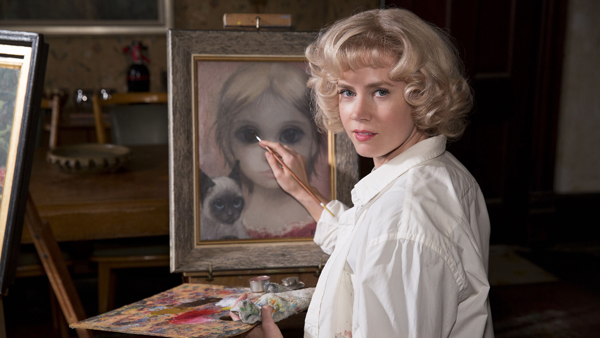
Named after the most prominent feature in the paintings of artist Margaret Keane, whose whimsical depictions of children with enlarged eyes became ubiquitous in the 1950s, Big Eyes tells the true story of the artist who painted those eyes and how for quite some time no one knew it was her.
The film opens with Margaret (Amy Adams) boldly leaving her first husband and taking her daughter with her to live in San Francisco. It is there that she meets Walter Keane (Waltz) a charismatic cityscape artist selling his mediocre paintings for 10 times what she, as a female artist, is able to make. Equal parts charming, menacing and meek, Waltz hams it up as the huckster Walter, who is able to sell, promote and manage Margaret’s big-eye paintings, with the minor caveat that he may have, sort of, told the buyers that they were his paintings. As the popularity of the paintings increases, so to0 does Keane’s prosperity, as does Margaret’s discontent.
Adams is effective as Margaret Keane, but she falls victim to the same plight of the woman she portrays. Big Eyes focuses mostly on the showman in the family, the same way the world focused on him, thinking him to be the painter of the big-eyed children, and Waltz (as did Walter) steals the show; not necessarily by sheer talent alone, but by opportunity, as the majority of the movie shows Walter lying, selling and living it up only to cut back to Margaret diligently painting his next masterpiece for him. The film very nearly becomes about Walter’s descent into madness as he begins to believe the lie, but the paintings and the story are hers, and so there should have been even more attention given to her internal and external struggle against a patriarch and the patriarchy.
That said, the true story behind Big Eyes is a remarkable one that hits all the hallmarks of great drama: seduction, greed, betrayal, fraud, mid-20th-century sexism, courtroom trials, etc., but the most surprising thing about this sometimes boilerplate biopic is that it was directed by Tim Burton. Maybe Burton has mellowed with age, but the standard, garish gothicisms of his post-millennial output are thankfully absent. Instead Keane’s tale is told through the hypercolor lens of a Scissorhandsian suburbia, perfectly matching her vivid paintings and the mid-century modern setting. This is subtlety for Burton, and though the film can be disjointed at times, and favors the antagonist over the protagonist, Big Eyes is no less a worthy conveyance for Margaret Keane’s intriguing true story and her truly unique, often stolen, artistic style.












